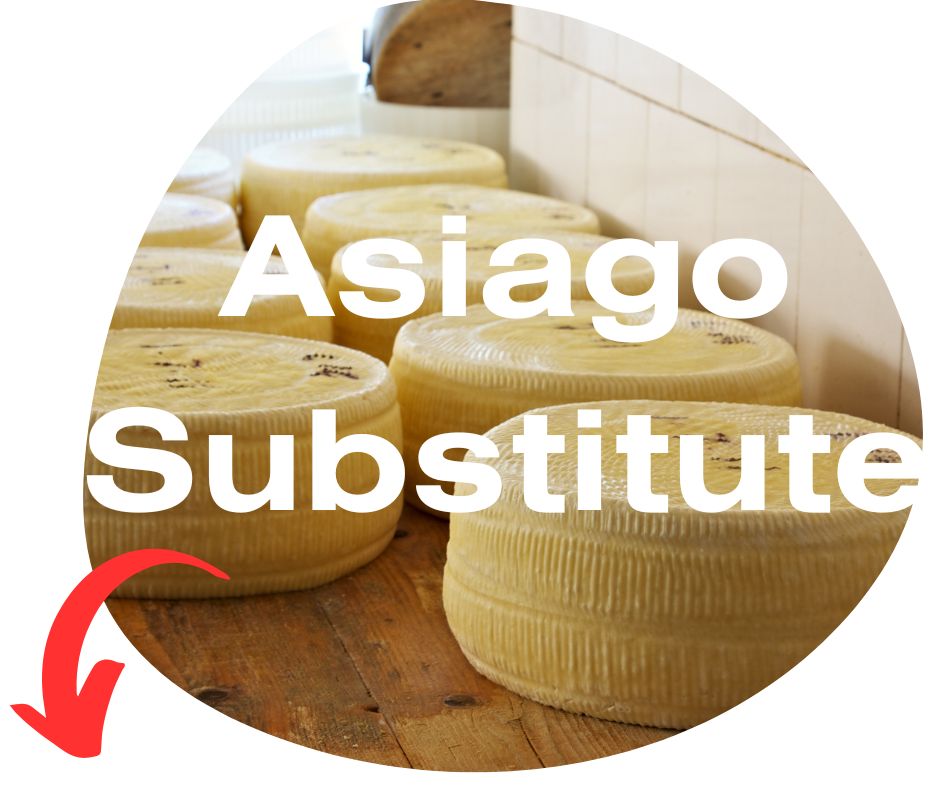Last Updated on August 31, 2023 by Aaron
Asiago cheese originates from the Veneto and Trentino regions of Italy. The rich grasslands of the Asiago plateau grant the cheese a special terroir, embedding it with flavors reminiscent of the local environment.

If you’re looking for a cheese similar to Asiago to use as a substitute, there are several that can work very well, depending on the purpose.
These cheeses share not only geographical origins in Italy but also heritage, tradition, and often similar production methods. However, each one possesses unique characteristics that make it stand out. Still, in the context of substituting for Asiago in various dishes, they can often seamlessly fill the role due to their overlapping qualities.
If you’re in a hurry…
| Cheeses | Key Similarity | Tips |
| Parmesan | Hard texture suitable for grating; rich, nutty flavor. | More intense and saltier than Asiago. |
| Pecorino Romano | Hard texture suitable for grating; savory flavor. | Made from sheep’s milk leading to a tangier taste; saltier than Asiago. |
| Grana Padano | Hard, crumbly texture and a savory, slightly sweet flavor. | Milder and less salty than Parmesan, but similar to Asiago in many respects. |
| Fontina | Creamy, nutty flavor; excellent melting qualities similar to fresh Asiago. | Softer and more pliable; exhibits an earthy, mushroom hint, especially when matured. |
Parmesan (Parmigiano-Reggiano)

Hailing from the Emilia-Romagna and Lombardy regions of Italy, Parmigiano-Reggiano has a storied history dating back at least nine centuries. It’s a staple in Italian cuisine.
Both Parmesan and Asiago are hard cheeses that undergo a long aging process, which develops their crumbly texture and deep, nuanced flavors. Both cheeses are frequently used for grating over dishes, particularly pastas. The rich, nutty taste of Parmesan can often mimic that of an aged Asiago. However, Parmesan’s flavor profile is typically more intense and saltier.
Parmesan cheese matures for a longer duration, imparting a more intricate and profound flavor. However, there’s a younger asiago that’s aged for a few months, boasting a softer texture and a notably sweeter and creamier taste.
Read more in Asiago vs. Parmesan
Pecorino Romano

Originating from Rome, Pecorino Romano is one of Italy’s oldest cheeses. Made from sheep’s milk, it has been a fundamental part of Roman cuisine for millennia.
Like Asiago, Pecorino Romano is a hard cheese perfect for grating.
Pecorino Romano’s flavor is distinctive, with its pronounced saltiness and a sharp, tangy undertone. While Asiago is milder, an aged Asiago (known as Asiago Vecchio) can still offer a pronounced flavor, making it a cheese that can stand up to the robustness of Pecorino Romano.
One of the primary differences between the two cheeses is the milk from which they are made. Asiago is crafted from cow’s milk, giving it a creamier and more buttery profile. In contrast, Pecorino Romano is made from sheep’s milk, which imparts a more robust and tangy flavor. This sheep’s milk gives Pecorino Romano its characteristic piquant taste and a slightly oily texture.
On the other hand, Pecorino Romano, made from sheep’s milk, typically has a higher fat content and more calories than cow’s milk cheeses like Asiago. Additionally, sheep’s milk provides more vitamins and minerals, especially calcium and zinc, than cow’s milk.
Read more in Asiago vs. Pecorino
Grana Padano

Produced in the Po River Valley in Northern Italy, Grana Padano is a semi-fat hard cheese. It’s one of the world’s first hard cheeses, created nearly 1,000 years ago by Cistercian monks.
Grana Padano has a rich, savory, and slightly sweet flavor. While it shares many flavor characteristics with Parmigiano-Reggiano, Grana Padano is often described as being milder and less salty. Aged Asiago also possesses a deep and nutty flavor, making it comparable to Grana Padano in many dishes.
Just like Asiago, Grana Padano is often used as a grating cheese in Italian cuisine. It can be sprinkled over pasta, risotto, and salads or consumed as-is in slices, making them interchangeable in certain recipes.
Fontina Val d’Aosta

Fontina comes from the Aosta Valley in the Alps. It’s a semi-soft cheese with a strong flavor, made from cow’s milk and boasting a DOP (Protected Designation of Origin) status. Its rind is typically washed, which gives it a distinct, orangish-brown color.
While the texture of Fontina is softer than hard Asiago, its flavor profile can be reminiscent of a young, fresher Pressato Asiago (1-3 months of aging). They share a mild, somewhat nutty flavor, and a buttery quality when melted. Fontina’s taste is creamy and earthy, with a hint of mushroom, especially as it matures. This earthiness can provide a depth that is reminiscent of the richness found in Asiago.
One of the standout characteristics of Fontina is its exceptional melting quality. Asiago, especially when young, also melts well. If a recipe requires smooth, creamy melted cheese, both Fontina and Asiago can fulfill this role. However, aged Asiago (Asiago Vecchio) is harder and less suitable for melting compared to young Asiago.
Read more in Asiago vs. Fontina
Can you Substitute Mozzarella for Asiago Cheese?
You can substitute young asiago (also called Asiago Pressato) for mozzarella. Young Asiago is only briefly cured few a months, which has a milder and milky taste.
When considering substituting mozzarella for Asiago cheese, be aware of significant differences: Asiago has a sharper and tangier flavor compared to the milder taste of mozzarella. Texture varies with fresh mozzarella being soft and moist, while Asiago can range from semi-soft to hard. Mozzarella melts into a gooey consistency, whereas Asiago’s melt quality depends on its age and is likely not as smooth and won’t have the same stringy effect.
If it’s just for a topping or a minor component, the switch should be relatively straightforward. However, if the cheese is a primary flavor or texture component, you may need to adjust other ingredients to compensate for the differences.

